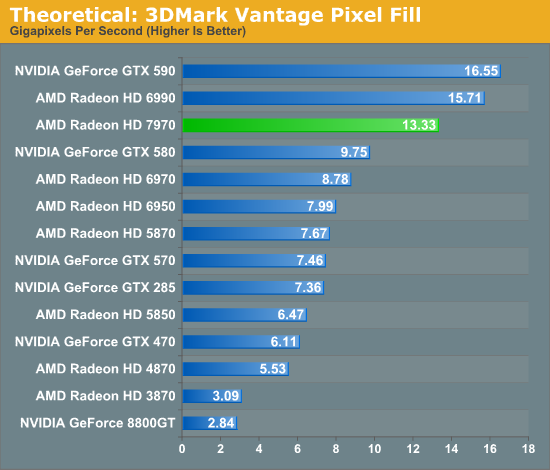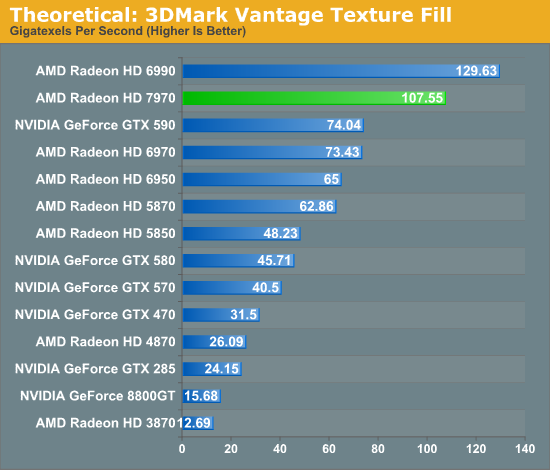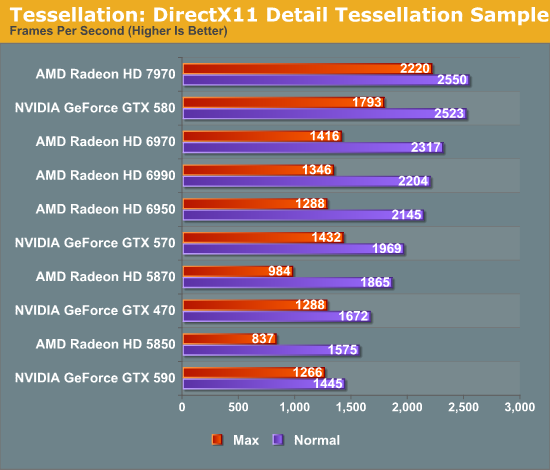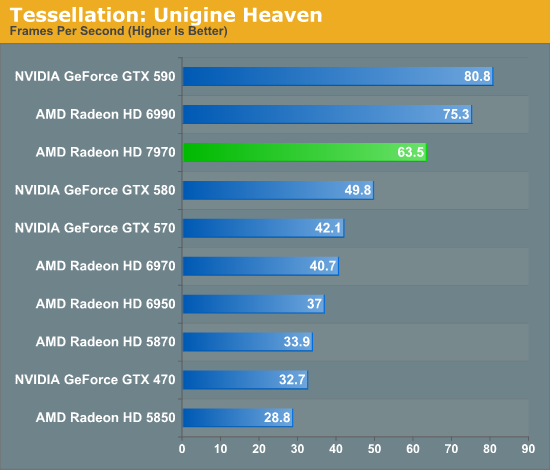AMD Radeon HD 7970 Review: 28nm And Graphics Core Next, Together As One
by Ryan Smith on December 22, 2011 12:00 AM EST- Posted in
- GPUs
- AMD
- Radeon
- ATI
- Radeon HD 7000
Theoreticals & Tessellation
From a rendering perspective one of the most interesting things AMD did with Tahiti was what they didn’t do: they didn’t add more ROPs, they didn’t add more geometry engines. And yet based on our game performance they’ve clearly improved on their performance in those situations by making more efficient use of the hardware they do have.
So we wanted to take a quick look at synthetic performance to see what these tools had to say about AMD’s changes. We’ve included the numbers for every other GPU in our lineup as a reference point, but we would strongly suggest against reading into them too much. AMD versus AMD is sometimes relevant to real world performance; AMD versus NVIDIA rarely is.

We’ll start with 3DMark Vantage and its color fill test. This is basically a ROP test that attempts to have a GPU’s ROPs blend as many pixels as it can. Theoretically AMD can do 32 color operations per clock on Tahiti, which at 925MHz for 7970 means the theoretical limit is 29.6Gpix/sec; not that any architecture is ever that efficient. In practice 7970 hits 13.33Gpix/sec, which is still well short of the theoretical maximum, but pay close attention to 7970’s performance relative to 6970. Even with the same number of ROPs and a similar theoretical performance limit (29.6 vs 28.16), 7970 is pushing 51% more pixels than 6970 is.
In designing Tahiti AMD said that they didn’t need more ROPs they just needed more efficient ROPs, and it looks like they’ve delivered on this. It’s not clear whether this is the limit for efficiency or if AMD can squeeze more out of their ROPs in future designs, but this definitely helps to prove that there’s more to graphics rendering than a large number of functional units.

Our other 3DMark synthetic benchmark is the 3DMark Vantage Texture Blend test, which measures how quickly a GPU can blend multiple FP16 textures. This is more synthetic than most tests because FP16 textures aren’t widely used, but it’s a consistent benchmark.
The theoretical performance improvement from 6970 to 7970 is 40% - 33% more texture units operating at a 5% higher clockspeed. In practice the 7970 exceeds that improvement by increasing texture performance by 46%, meaning the 7970 has benefitted from more than the increase in texture units. Most likely the new cache architecture has further improved the efficiency of the texture units, although the 3DMark texture set is not particularly large.
Moving on, we also wanted to take a look at tessellation. AMD did not increase the theoretical geometry performance of Tahiti as compared to Cayman – both top out at 2 triangles per clock – but AMD has put a lot of effort into improving the efficiency of Tahiti’s geometry units as we’ve seen reflected in our game benchmarks.

Our first tessellation benchmark is the traditional Detail Tessellation sample program from the DirectX SDK. Here we’re looking at tessellation performance as a product of the framerate, testing at tessellation factors 7 (normal) and 15 (max). Traditionally this is a test that has been rather balanced at normal tessellation levels, while NVIDIA cards with their superior geometry throughput have been the top performers at maximum tessellation levels. So it’s all the more interesting when we’ve seen the tables turned; the 7970 is merely competitive with the GTX 580 at normal tessellation levels, but now it’s ahead of the GTX 580 by 24%. More significantly however the 7970 is ahead of the 6970 by 57%.

Our second tessellation benchmark is Unigine Heaven, a benchmark that straddles the line between a synthetic benchmark and a real-world benchmark, as the engine is licensed but no notable DX11 games have been produced using it yet. In any case the Heaven benchmark is notable for its heavy use of tessellation, which means it’s largely a proxy test for tessellation performance.
As with the Detail Tessellation sample program, Heaven shows significant gains for the 7970 versus the 6970, with the 7970 leading by 56%. Meanwhile it leads the GTX 580 by 27%, which is actually slightly better than what we saw under the more “pure” Detail Tessellation sample. Between these two benchmarks it’s clear that AMD’s tessellation efficiency improvements are quite real, and that with Tahiti AMD can deliver much better tessellation performance than Cayman even at virtually the same theoretical triangle throughput rate.
Of course one has to wonder what NVIDIA will have in store for Kepler next year. Their current Fermi design seems to scale well with additional geometry units, but if Tahiti is anything to go by, there’s a great deal to be gained just by focusing on efficiency. NVIDIA has prided themselves on their geometry performance since before GF100 even shipped, so it will be interesting if they have anything in store to hold on to that distinction.










292 Comments
View All Comments
Esbornia - Thursday, December 22, 2011 - link
Fan boy much?CeriseCogburn - Thursday, March 8, 2012 - link
Finally, piroroadkill, Esbornia - the gentleman ericore merely stated what all the articles here have done as analysis while the radeonite fans repeated it ad infinitum screaming nvidia's giant core count doesn't give the percentage increase it should considering transistor increase.Now, when it's amd's turn, we get ericore under 3 attacks in a row...---
So you three all take it back concerning fermi ?
maverickuw - Thursday, December 22, 2011 - link
I want to know when the 7950 will come out and hopefully it'll come out at $400duploxxx - Thursday, December 22, 2011 - link
Only the fact that ATI is able to bring a new architecture on a new process and result in such a performance increase for that power consumption is a clear winner.looking at the past with Fermy 1st launch and even Cayman VLIW4 they had much more issues to start with.
nice job, while probably nv680 will be more performing it will take them at least a while to release that product and it will need to be also huge in size.
ecuador - Thursday, December 22, 2011 - link
Nice review, although I really think testing 1680x1050 for a $550 is a big waste of time, which could have to perhaps multi-monitor testing etc.Esbornia - Thursday, December 22, 2011 - link
Its Anand you should expect this kind of shiet.Ryan Smith - Thursday, December 22, 2011 - link
In this case the purpose of 1680 is to allow us to draw comparisons to low-end cards and older cards, which is something we consider to be important. The 8800GT and 3870 in particular do not offer meaningful performance at 1920.poohbear - Thursday, December 22, 2011 - link
Why do you bencmark @ 1920x1200 resolution? according to the Steam December survey only 8% of gamers have that resolution, whereas 24% have 1920x1080 and 18% use 1680x1050 (the 2 most popular). Also, minimum FPS would be nice to know in your benchmarks, that is really useful for us! just a heads up for next time u benchmark a video card! Otherwise nice review! lotsa good info at the beginning!:)Galcobar - Thursday, December 22, 2011 - link
Page 4, comments section.Esbornia - Thursday, December 22, 2011 - link
They dont want to show the improvements on min FPS cause they hate AMD, you should know that already.